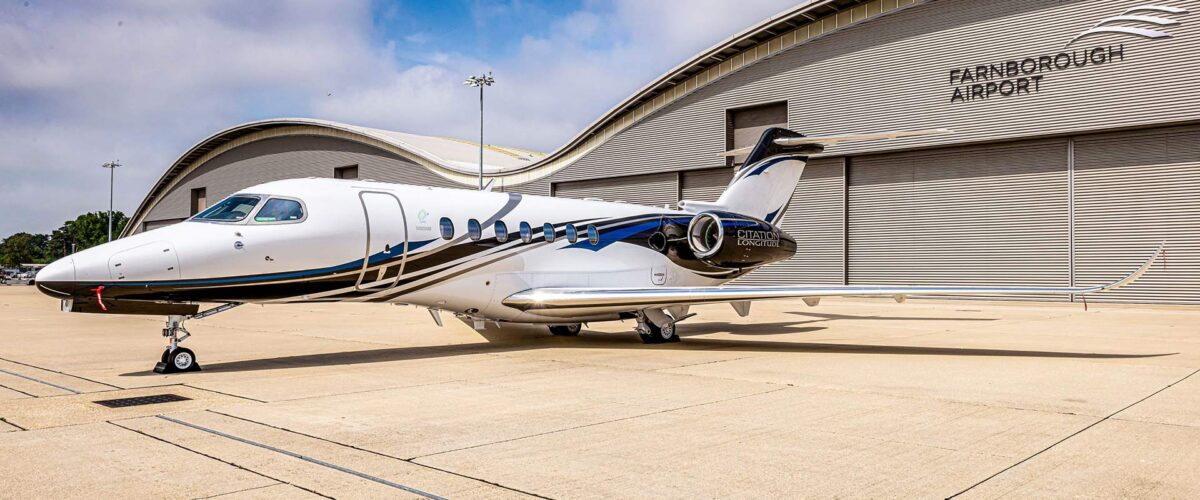A Cessna Citation VII business jet will be adapted for the first full-scale flight test of Airbus UpNext’s eXtra Performance Wing demonstrator program.
The eXtra Performance Wing demonstrator program has gained regulatory approval for the modifications on a Cessna Citation to test the concept of inflight folding wingtips, and other active control technologies, to improve and optimise wing aerodynamics and performance. Launched in September 2021, Airbus (Toulouse, France) along with engineers at the National Composites Centre (an R&D center for advanced composites in Bristol, U.K.) have been working on the program to develop and validate active control technologies that can adapt the wing shape and area to reduce drag, and therefore fuel burn, on any propulsion system. The aim, as part of Airbus’ decarbonization target, is ultimately to reduce CO₂ emissions from less fuel use.
Airbus UpNext is a wholly-owned Airbus fast-track R&D subsidiary, that accelerates and validates technology advancements, developing and testing proof of concepts through to ground and flight tests quickly and efficiently.
AlbatrossONE – Validating the Concept of Semi-Aeroelastic Hinged Wings
The eXtra Performance Wing demonstrator project followed on from the initial successful small-scale validation project AlbatrossONE, which was undertaken in 2019. AlbatrossONE was a 1/14th scale model of an Airbus A321 with an increased-span wing to reduce cruise drag. This initial project investigated the concept of semi-aeroelastic hinged wings that are locked for takeoff and landing but can be unlocked during flight, adapting the shape, span and surface of the wings when subjected to wind gusts or turbulency. The design is similar to an albatross or eagle who use their wings and longer tailing feathers to control flight. This biologically inspired engineering idea (biomimicry) goes back to nature, and in essence the concept of flying, to find solutions to increase aircraft performance.
AlbatrossONE demonstrated freely ‘flapping’ wings were possible. These early tests showed folding wings could be statically and dynamically stable throughout the flight and that the wingtips could also be controlled and fixed when needed. It also proved that an unlocked hinge, which allows the wing to move freely in response to the wind gusts, alleviates the load on the wing.
Wind Tunnel Testing of the eXtra Performance Wing Design
In April 2022 the wind tunnel testing of the eXtra Performance Wing design was completed using a remote-controlled scaled-down version of a Cessna Citation with the semi-aeroelastic hinged wings and composite lightweight, long-span design. The composite materials deliver the strength and flexibility that the eXtra Performance Wing demands and is another aspect of the design that uses novel manufacturing technologies. The hinge also allows the wing to be folded when on the ground so the wing can be longer and more slender.
The partly 3D-printed wind tunnel, built by the Airbus aerodynamic team at the low-speed, wind tunnel facility in Filton near Bristol, is itself cutting-edge technology. It provides an ideal means to validate concepts on a smaller scale before flight tests. The wind tunnel replicates take-off and landing wind speed conditions, enabling performance and capabilities to be measured and analysed, expediting the concept to the development phase. The testing facility is also used for testing F1 cars, maritime systems and other aircraft designs.
Demonstrating the eXtra Performance Wing Technology on a Cessna Citation
The next phase of the eXtra Performance Wing project is to demonstrate the technology on a test aircraft. The French Civil Aviation Authority has recently granted Part 145 Appendix 1 approval for Aerotec Concept, the Blagnac-based modification firm, to undertake the conversion.
An unmodified Cessna Citation VII business jet will first undergo flight tests to establish the baseline performance. It will then be converted to remote control and modified with the increased-span composite wing and a 2 m (6.6-ft.) movable semi-aeroelastic hinged wingtip section.
The Cessna Citation test aircraft will also be equipped with:
- gust sensors located on the nose of the aircraft to detect incoming gusts that immediately send a signal to the wingtip hinge which releases before the gust hits the wing,
- pop-up spoilers that can be rapidly deflected perpendicular to airflow, and
- multifunctional trailing edges that dynamically change the surface of the wing.
All to enable the active control of the wing.
The semi-aeroelastic hinged wingtip will be attached to the end of the high-aspect-ratio composite test wing with an electrically powered actuating hinge mechanism, that includes a drive gear system and clutch. Curtiss-Wright has developed the electro-mechanical actuation system that controls the hinge. It will operate in two main modes – the wingtip can either be moved in a powered way or set to move freely. The electric motor will drive ring gears to position the wingtip at particular angles for different flight modes, as well as takeoff and landing. The drive mechanism can then be disengaged to allow the wingtip to move freely on its semi-aeroelastic hinge during flight, receiving position instructions from a flight control computer.
Flight testing of the whole system on the modified Cessna Citation VII business jet is expected to begin in 2024.
Summary
A Cessna Citation VII business jet will be used to test Airbus’ new folding eXtra Performance Wing. The wing is made of composite materials and has a hinge that allows it to move freely in response to wind gusts, which alleviates the load on the wing. The eXtra Performance Wing demonstrator program looks promising to improve and optimise wing aerodynamics and performance, and consequently reduce fuel burn and therefore CO₂ emissions.
Airbus’ demonstrator program is a great example of innovative solutions to decarbonise the aviation sector. The program suggests that significant strides are being made in active wing control technology, inspired by biomimicry. The growing use of composite materials in aircraft wing design, as well as their evolution and application in other sectors, further demonstrate the advancement of aviation technology and its potential to create new avenues.
The testing so far has been successful, and a test flight of the new wing technologies on a full-sized Cessna Citation VII business jet is next.
Feature image credit Cessna


